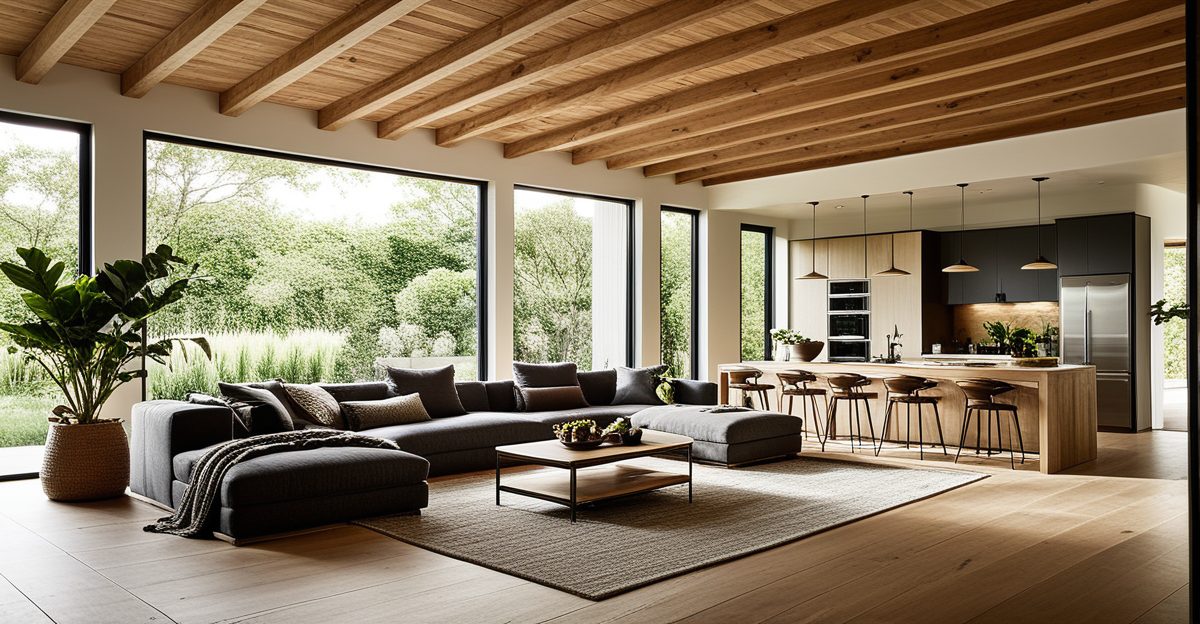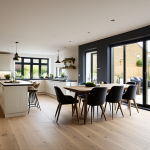The Fundamentals of Sustainable Home Decor
Sustainable home decor centers on eco-friendly home design principles that minimize environmental impact while enhancing living spaces. It involves selecting materials and practices that are renewable, recyclable, or reused, promoting durability and reducing waste. Core principles include resource conservation, responsible sourcing, and reducing carbon footprints.
Materials qualifying as sustainable often feature natural fibers like organic cotton or hemp, responsibly harvested bamboo, reclaimed wood, and low-VOC paints. These choices align with green interior design concepts by combining environmental responsibility with aesthetic appeal. For instance, reclaimed wood furniture not only limits deforestation but also adds warmth and unique character to interiors.
Also read : How Can We Create a Cozy Ambience in Our UK Homes Without Major Renovations?
Eco-friendly home design also emphasizes functionality alongside beauty. Space-saving furniture made from recycled components and energy-efficient lighting fixtures contribute to reduced resource consumption. Sustainable home decor creates an inviting environment that supports wellness and reflects personal values. By adopting these practices, homeowners can enjoy stylish interiors that honor the planet, embodying what sustainable home decor truly means.
Environmental Impact and Benefits
Sustainable home decor plays a crucial role in reducing your environmental impact by prioritizing eco-friendly materials. Using reclaimed wood, bamboo, recycled metals, and other natural resources lowers the demand for virgin materials, which helps conserve forests, reduce mining, and minimize waste. These eco-friendly materials are renewable and often sourced with minimal processing, further shrinking the carbon footprint of home furnishings.
Also read : What are the most effective ways to insulate UK properties?
One key question is, how does sustainable decor actively reduce environmental harm? The answer lies in its emphasis on durability and lifecycle thinking. Durable goods avoid frequent replacement, cutting down landfill contributions. Additionally, many sustainable products are designed for easy repair or upcycling—transforming old items into new décor pieces. Upcycling not only gives materials a second life but also fosters creativity and uniqueness in green interior design.
Repurposing items reduces waste and resource consumption by diverting materials from landfills. For example, transforming an old ladder into a bookshelf creates functional art and exemplifies eco-friendly home design’s commitment to sustainability. Collectively, these approaches enable homeowners to contribute to a healthier planet without sacrificing style or function.
Health and Wellness Advantages
Creating a healthy home is a vital component of sustainable home decor. Using non-toxic materials like low-VOC paints, natural fibers, and organic finishes reduces harmful chemicals, which can otherwise degrade indoor air quality. Why is this important? Improved indoor air quality lessens respiratory issues, allergy symptoms, and overall exposure to pollutants, promoting better health for all household members.
Sustainable home decor supports well-being by prioritizing natural finishes free from synthetic additives. For example, furniture made from untreated reclaimed wood or organic textiles avoids off-gassing—a common problem with conventional furnishings. This means fewer airborne toxins and a fresher living environment.
In addition to safer materials, thoughtful eco-friendly home design considers ventilation and lighting, further enhancing indoor air quality and comfort. Plants often complement green interiors by naturally filtering air, adding both aesthetic appeal and health benefits.
Ultimately, selecting sustainable choices fosters a nurturing living space that actively supports wellness. These holistic design decisions create a home that’s not only stylish but also a sanctuary for physical and mental health. This connection between green interior design and wellbeing highlights a powerful dimension of sustainable living to embrace.
Practical Ways to Make Your Decor More Sustainable
Small changes can lead to significant lifestyle improvements when adopting sustainable home decor. What are the best practical steps? Start by focusing on everyday items like lighting, textiles, and furniture. Switching to energy-efficient LED bulbs reduces electricity usage without compromising style. Choosing organic, recycled, or upcycled fabrics for cushions and curtains lowers reliance on resource-heavy textiles.
Selecting pieces from reputable sustainable brands ensures products meet environmental standards. Look for certifications like FSC for wood or GOTS for textiles, which verify responsible sourcing and manufacturing. These guarantees help avoid greenwashing and promote genuine eco-friendly home design.
Budget-conscious shoppers can embrace sustainability by repurposing existing furniture with non-toxic paints or simple repairs rather than replacing items. Thrift stores and online marketplaces offer affordable, sustainable options to refresh décor without excess consumption.
Combining these eco-friendly tips efficiently balances aesthetics, durability, and environmental responsibility. By integrating thoughtful purchasing habits and creative reuse, homeowners can cultivate stylish spaces aligned with green interior design principles, making sustainable living both accessible and rewarding.
Enhancing Comfort and Style
Balancing sustainable style with comfort is essential in modern eco-friendly home design. Sustainable home decor can be both elegant and inviting, proving that green interiors don’t sacrifice warmth or character. One effective way to blend sustainability with style is choosing furnishings that use natural, renewable materials while maintaining aesthetic appeal.
How can you incorporate sustainable elements without compromising comfort? Prioritize textiles made from organic cotton or hemp, which are soft, breathable, and eco-friendly. Opt for furniture with ergonomic design crafted from reclaimed wood or bamboo—these choices offer durability and visual charm. Additionally, layering natural fibers like wool or jute rugs adds texture and cozy warmth, enhancing comfort.
Visual inspiration often highlights before-and-after transformations where eco-friendly pieces rejuvenate spaces with character and function. Incorporating plants and natural light complements this sustainable style, creating fresh, lively atmospheres.
To sum up, sustainable home decor does not mean choosing between comfort and style. Thoughtful selection of materials, textures, and layout can produce interiors that are visually appealing, cozy, and aligned with green interior design values. Embrace the harmony of form and function to elevate your living space sustainably.





